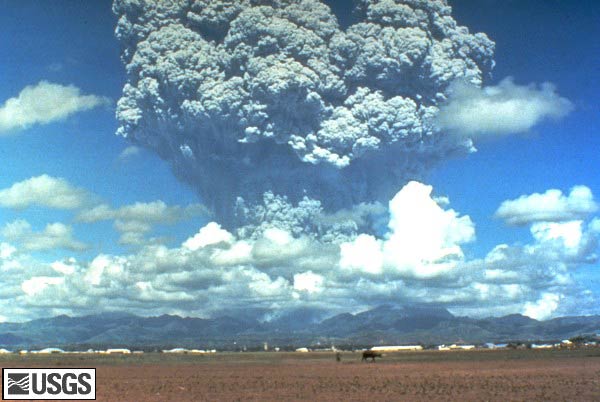Pinatubo Flashback, June 12, 1991: A Big Bang

On June 15, 1991, the largest land volcano eruption in living history shook the Philippine island of Luzon as Mount Pinatubo, a formerly unassuming lump of jungle-covered slopes, blew its top. Ash fell as far away as Singapore, and in the year to follow, volcanic particles in the atmosphere would lower global temperatures by an average of 0.9 degrees Fahrenheit (0.5 degrees Celsius). Twenty years after Pinatubo, LiveScience is reliving the largest eruption in the modern era based on what we know now. Join us each day through June 15 for a blow-by-blow account of what happened. [Read all installments: June 7, June 8, June 9, June 10, June 11, June 12, June 13, June 14]
June 12, 1991 - The residents of the island of Luzon in the Philippines have been holding their breath waiting for an explosive eruption from Mount Pinatubo. Today, on Philippines Independence Day, they get one. In fact, they get two.
At 8:51 a.m. local time, the seismometers on Mount Pinatubo's flanks go haywire as the volcano erupts. A column of ash and steam climbs 11 miles (19 kilometers) into the air as fast as an F-15 jet.
"When you're near an eruption like that you don't hear it," John Ewert, a USGS geologist who was part of the team monitoring the volcano, told LiveScience. "Instead what people got was, their ears would pop. That was the pressure wave."
Richard Hoblitt, another USGS volcanologist, also witnesses the volcano eruption.
"This may sound a little odd, but one of our first emotions was relief that we were justified in our concern and admonitions to people that this was a serious situation," Hoblitt told LIveScience.
Hoblitt's greatest worry during the first eruption is that the cloud of hot gases and rock is going to collapse, creating high-speed molten avalanches called pyroclastic flows. These flows can travel faster than 50 miles (80 km) an hour and reach temperatures up to 1,292 degrees Fahrenheit (700 degrees Celsius). Fortunately, the density of the ash cloud is low enough that the ejected gas and rock spews upward into the atmosphere instead of roiling toward the ground.
Sign up for the Live Science daily newsletter now
Get the world’s most fascinating discoveries delivered straight to your inbox.
The eruption lasts only about forty minutes, but the feeling of relief at the short duration is quickly replaced by concern as the ground begins to shake again. Following a few hours of earthquake swarms, Pinatubo blows out again at 10:52 p.m. This eruption lasts only 14 minutes.
The explosions prompt the evacuation of 600 of the 1,500 remaining military personnel at Clark Airbase, and civilians within 18 miles (30 km) of the mountain are urged to get out. The latest evacuation orders bring the number of displaced people to at least 58,000, but Ewert, Hoblitt and their crew aren't going anywhere — in fact, Hoblitt hops on a helicopter before the first eruption even ends to get a closer look.
So far, the winds are blowing the ash away from Clark Airbase. But the geologists know from old volcanic deposits that Pinatubo could send pyroclastic flows as far as their headquarters.
"There was lots of concern about where we were and whether or not we were far enough away," Ewert said.
Tomorrow: Pinatubo doesn't back down.
You can follow LiveScience senior writer Stephanie Pappas on Twitter @sipappas. Follow LiveScience for the latest in science news and discoveries on Twitter @livescience and on Facebook.

Stephanie Pappas is a contributing writer for Live Science, covering topics ranging from geoscience to archaeology to the human brain and behavior. She was previously a senior writer for Live Science but is now a freelancer based in Denver, Colorado, and regularly contributes to Scientific American and The Monitor, the monthly magazine of the American Psychological Association. Stephanie received a bachelor's degree in psychology from the University of South Carolina and a graduate certificate in science communication from the University of California, Santa Cruz.









